REEL RETRO CINEMA: And its Marvel Comics adaptation…

—
Star Trek: The Motion Picture was officially released in theaters Dec. 7, 1979. Some snarkier folks might joke that it would be a day that would live in Star Trek infamy. I’m not among those. TMP has its sometimes considerable flaws but it holds up better than you might expect. (My almost 21-year-old son considers it his favorite Trek film. Click here to check out his 13 QUICK THOUGHTS on why the film is an underrated masterpiece.)
In any event, its release was a watershed moment — and without it, we’d never get the brilliant follow-up Star Trek II: The Wrath of Khan, the greatest of all Star Trek stories.
So with the 40th anniversary upon us, I’ve invited our resident film critic Rob Kelly to take another look at this oft-maligned project and, as he does in these REEL RETRO CINEMA columns, compare it to its comic-book adaptation.
(By the way, Rob has devoted several RRC columns to Trek in the past. Click here for Star Trek II; click here for Star Trek III; and click here for Star Trek IV.)
Live long and prosper. — Dan
—

By ROB KELLY
I pitched 13th Dimension majordomo Dan Greenfield a number of ideas for a new REEL RETRO CINEMA column, but when he informed me that the 40th anniversary of Star Trek: The Motion Picture was coming, I agreed that it was a worth a re-evaluation. After all, while I long considered Star Trek: The Motionless Picture to be by far the worst of the six original cast films, I love Trek in most of its forms so much I am almost always willing to give it another chance to impress me. (Just don’t ask me to do this for Nemesis, ok?)
At this point, almost anyone who cares knows the sordid tale: Originally conceived as a new TV series, the story that would form the basis of Star Trek: TMP would go through a torturous, absurdly extended birthing process. Literally years in the making, Paramount Pictures kept hitting creative brick walls during the development process but would never quite give up because they saw how much bank sci-fi adventures like Star Wars and Close Encounters of the Third Kind were making.
Backstage squabbles between the Great Bird of the Galaxy Gene Roddenberry and screenwriter Harold Livingston were so intense that when legendary director Robert Wise started shooting the film, they didn’t even have an ending worked out. It was up to some combo of Roddenberry, Wise, Livingston, William Shatner, Leonard Nimoy and sometimes even DeForest Kelley to collaborate and produce enough shootable scenes to keep the production moving forward.

Of course, this is less than ideal when making a movie: It’s inefficient, expensive, and slow. And that is not the only time that particular word will come up during this review.
The big gripe about Star Trek: TMP is that it is so very slow. At 132 minutes, it remains one of the longest films in the series. That, by itself, wouldn’t be a problem if more actually happened. The film starts promisingly enough: instead of Kirk, Spock, and the Enterprise, we are introduced to a new strain of Klingon, and we watch three of their fearsome Birds of Prey get destroyed by a mysterious force in deep space. So far, so good: this is recognizably Star Trek, but it’s been given a face (and forehead) lift: the make-up, sets, and special effects are all top-notch, thanks to the work of visual genius Douglas Trumbull (2001: A Space Odyssey).
We are then reintroduced to now Admiral Kirk, who has been away from the captain’s chair for a few years, and is itching (and not just because of the uniforms) to get back to it. When the mysterious threat that took out the Klingons gets too close to Earth, the Federation sends out the Enterprise to investigate, and decides it needs an old hand (many, actually) at the wheel.
So they take the ship away from its current captain, Will Decker (Stephen Collins), give it back to Kirk, along with Chekov, Uhura, Scotty, Sulu, and Dr. McCoy — the latter forced back into service against his will (and beard).
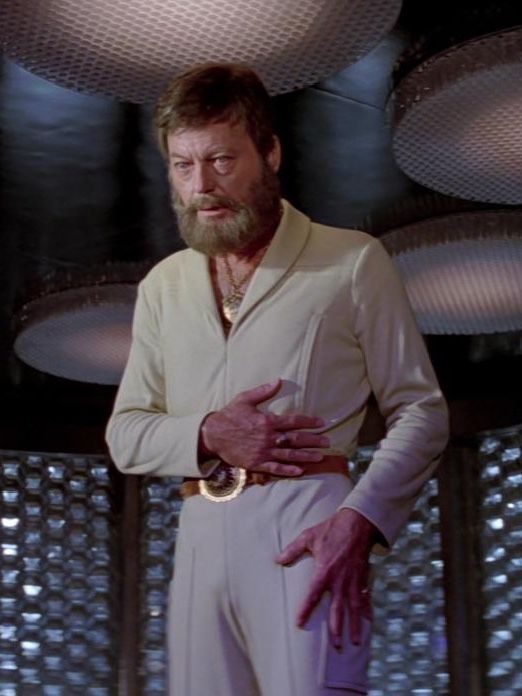
Decker believes Kirk is out of touch with what this new, refit Enterprise can do, and he’s right in some cases, but for the most part Decker is just an extraneous character. He stands around a lot, making googly eyes at former flame Ilia (Persis Khambatta), the other new face on the bridge, just hoping Kirk gets vaporized by a malfunctioning teleporter.
Of course, Mr. Spock is drafted into the proceedings eventually, after making like the Big Lebowski on Vulcan. And while it’s fun seeing these actors inhabit these characters again, it’s pretty clear that the script and director Wise just really didn’t know what to do with them once assembled, or how they should interact.
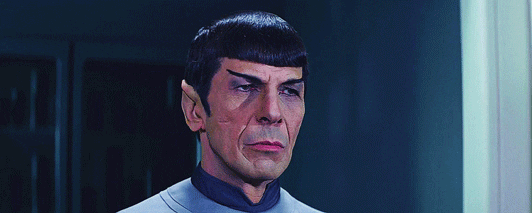
As portrayed in Star Trek: TMP, Spock isn’t merely emotionless, he’s a dick. He looks at his old friend “Jim” like a complete stranger and is straight up rude to his shipmates. Maybe this could have been played for laughs, but the filmmakers were so clearly going for a 2001-esque “serious sci-fi” vibe that the actors just look stranded.
It doesn’t help that for the vast majority of Star Trek: TMP, the visuals are so drab, the pacing so leaden. The uniforms are an eye-deadening light grey, accented with either tan or white. All the sets are two times too big (the bridge is so vast the people seem indistinct among the hardware) and under lit; for some reason the Federation thought it made sense to have their space explorers work in near darkness.
The matte paintings are pretty nifty, and it’s nice to see Star Trek given this kind of scale. But there are times when the audience is simply overwhelmed by all the detail. Take the scene where Scotty meets up with Kirk and they board a shuttlecraft to the new Enterprise: The sequence goes on forever, with endless cuts to the SFX shots, then back to Shatner reacting, then back to the SFX, then James Doohan reacting to Shatner’s reacting, etc. I get that this was the first time we’ve seen the Enterprise in a decade, and never this big, but right when the plot should be hitting warp speed, our heroes are, again, mostly just standing around.
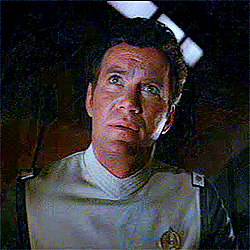
Speaking of our characters standing (or in this case sitting) around, it is criminal how underused Nichelle Nichols, George Takei, James Doohan, and Walter Keonig are; they get almost nothing to do other than stare at viewscreens, slack-jawed.
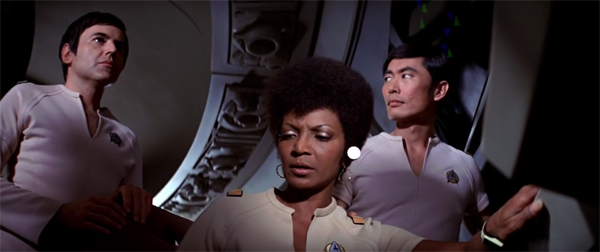
Sure, Kirk, Spock, and McCoy are the main event but there’s a reason why every Trek film has these characters: they are beloved and should be treated as more than props. For some reason the, uh, less than compelling performer Majel Barrett as Christine Chapel seems to get more lines, which had to be the work of Roddenberry, who as I mentioned was always fighting with Harold Livingston over their at times mutually exclusive approaches to the material.
And after all this build up—over an hour—once the Enterprise finally gets into space, with all our heroes aboard, they go out, meet the threat known as V’ger head on, and… just sorta talk to it. For a film over two hours, not much actually occurs.
Spock ponders a lot, and Kirk and McCoy talk about God and stuff, and Ilia gets zapped and then brought back to life, now dba a host body for V’ger. Then they all talk some more.
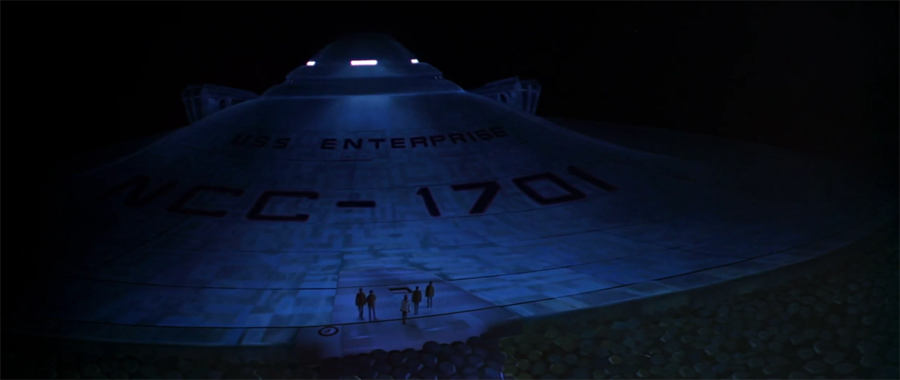
Finally, Kirk, Spock, McCoy and He’d-Wear-a-Red-Shirt-If-There-Were-Colors-In-This-Movie Decker take a trip into the heart of the machine, where they learn its origin, which I have to say is pretty clever; using a piece of actual human history and extrapolating from there. Decker then decides, mostly out of nowhere, he’d rather live as a sort of human/machine hybrid than be captain of the Enterprise, so he grabs Ilia and they do a sort of Close Encounters thing and disappear into nothingness. That leaves Kirk and crew to make a few jokes and head out for another adventure.

I realize I have spent a lot of time bashing this movie. I went into it believing it’s the worst of the original cast films, and I’m not sure I’ve changed my mind.
That said, some of it has aged better than I remember: Spock’s spacewalk into V’ger is beautifully staged and suitably awe-inspiring. The final sequence, while dramatically pretty inert, is visually compelling. As I mentioned at the top of this review, the opening gambit with the Klingons (sans subtitles, a nice touch) is well executed. It’s nice to see the Enterprise finally given the scale we know it has; on the Original Series even the engine room was barely bigger than a child’s bedroom closet; here, you actually get the feeling this is a massive vessel, with a suitably-sized crew to match.
And of course, all of this is a lot easier to take knowing that the Trek film series would course-correct and deliver like gangbusters in its very next installment, the still-classic Star Trek II: The Wrath of Khan. (Click here.)
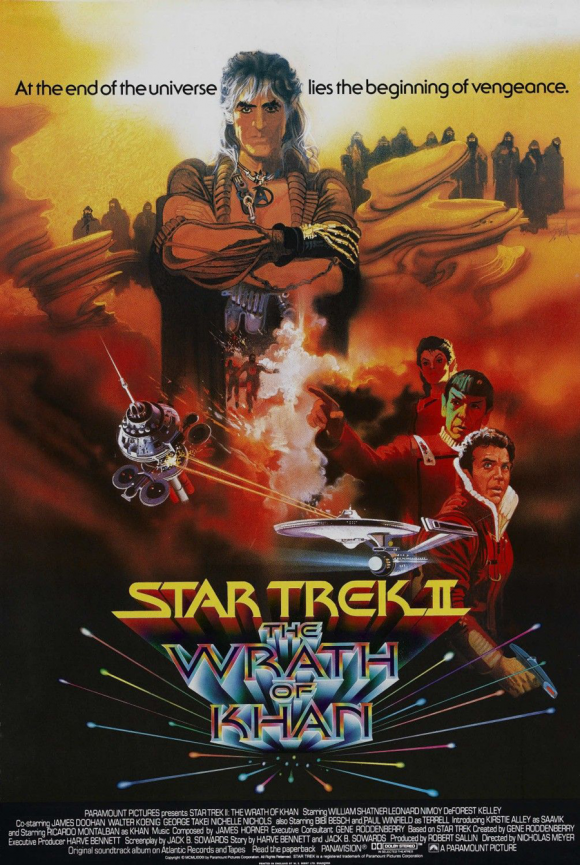
Star Trek: TMP’s flaws don’t seem so catastrophic in hindsight, when viewed in context as part of the series; instead, it feels like an interesting approach that ultimately doesn’t really work, but was worth a try, you know?
Speaking of alternate approaches, no REEL RETRO CINEMA column would be complete without mentioning the comic book adaptation. Marvel Comics, having acquired the license to Trek, adapted the film as both a regular-sized series and a Marvel Super Special — Issue #15 to be exact. (A Facsimile Edition of MSS #15 is due out from IDW on Dec. 18 — ads and all! Click here for details.)
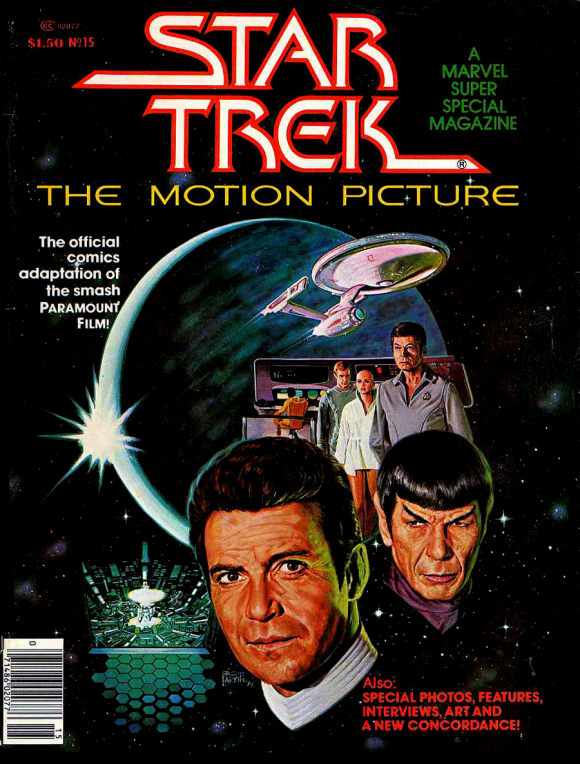
Cover art by Bob Larkin
Written by Marv Wolfman and drawn by the dynamite team of Dave Cockrum and Klaus Janson (who has never turned in an art job I didn’t like), this version of course has to eschew the long, sensuous pans of the Enterprise and V’ger, and basically just right to the meat of the story.
Legendary artist Marie Severin provides the coloring, and instead of using the film’s palate of grays and tans, she goes for vivid, primary hues, working in dazzling color holds and even some psychedelic background effects, and it really breathes life into what is essentially a think piece masquerading as a sci-fi adventure story.
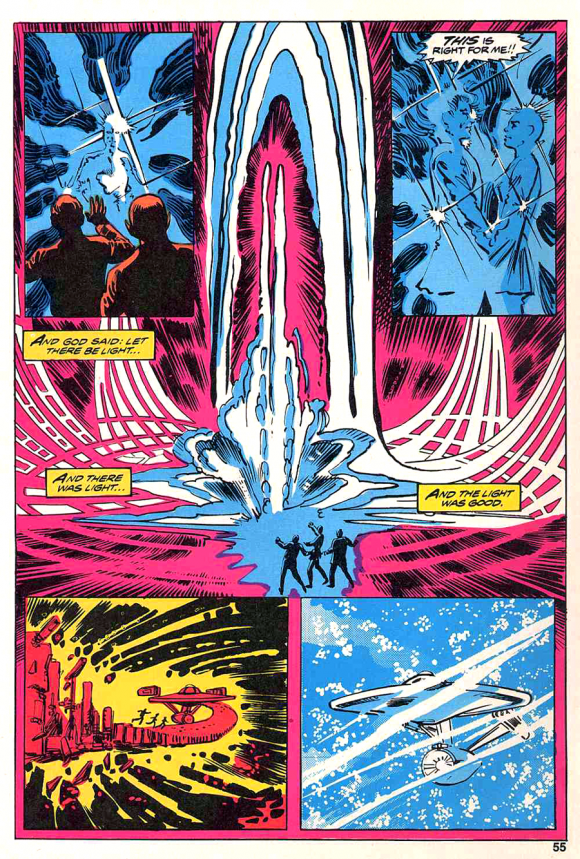
Wolfman manages to nip at the dialogue and lighten it up a bit, reminding one of how the characters behaved on the original show. It’s a total blast (sorry, llia, too soon?) to read and a textbook example of how to adapt something from another medium into a comic book. Ironically enough, it would be the only Trek film adaptation Marvel would ever get to do. Which is too bad of course, since the aforementioned action-packed Wrath of Khan would have made a superb comic book by these same hands.
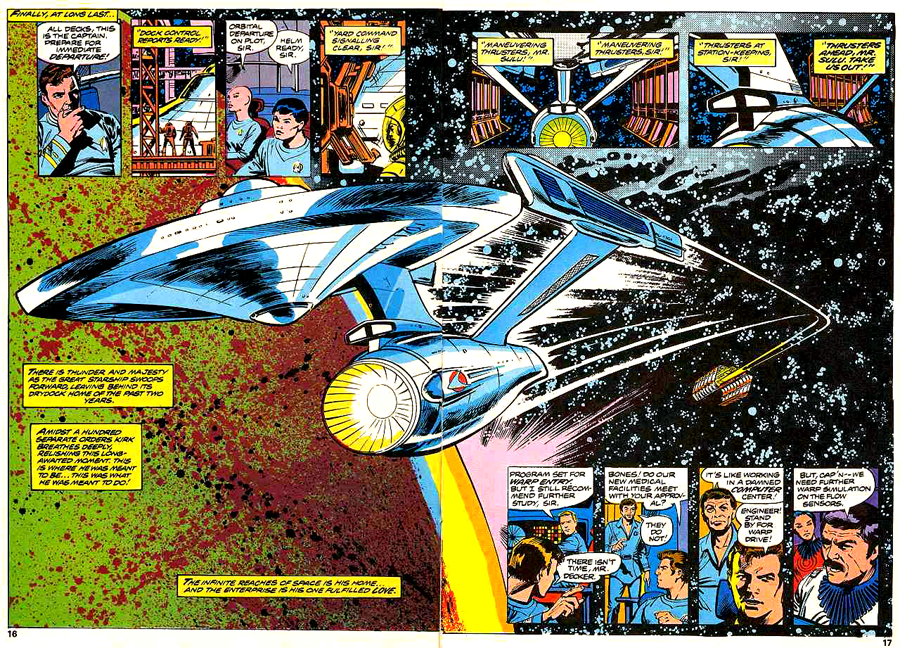
So even though I still come away from Star Trek: The Motion Picture less than satisfied, it seems to get a little better each time I watch it. Maybe as the original Trek recedes further and further into history I’ve become more forgiving; I know that we only have so many adventures with this particular group of actors playing these characters, so I take what I can get and enjoy as much as I can.
The V’ger hook is clever (and was basically lifted and reused for my favorite Trek film, The Voyage Home – click here), and the visuals can be dazzling.
I saw ST:TMP in its original release in 1979 (yes, I am old) but skipped it when I attended a Trek film marathon in the 1990s, so sure I was that I’d be bored to tears. But now that it’s been playing on the big screens once more this year? Not sure I’m going to skip it again. Maybe I’ll see you there!
—
MORE
— 13 QUICK THOUGHTS: Why STAR TREK: THE MOTION PICTURE is an Underrated Masterpiece. Click here.
— Marvel’s Classic STAR TREK: THE MOTION PICTURE Magazine to Be Re-Released. Click here.
—
Rob Kelly is a writer/artist/comics and film historian. He is the host or co-host of several shows on The Fire and Water Podcast Network, including Aquaman and Firestorm: The Fire and Water Podcast, The Film and Water Podcast, TreasuryCast, Superman Movie Minute, MASHCast and Pod Dylan.

December 7, 2019
I was so excited to see this movie when it came out…until I actually saw it. My friends and I walked out of the theater absolutely dumbfounded by what we had just seen (or not seen depending on your perspective). I don’t think I’ve ever anticipated a movie more, only to be that disappointed afterwards. I tried watching it again recently and just couldn’t get through it. It’s just such a mess, for all the reasons mentioned in the article.
BTW, as a fellow cover artist and friend of Bob’s, I’d like to credit the great Bob Larkin for the cover of the Marvel Comics adaptation.
December 7, 2019
Credit added. Thanks, Joe!
January 13, 2020
When I saw the film in Eau Claire when I was going to college, the theater was PACKED, the whole audience applauded at every introduction of the cast, and gave it a standing ovation at the end! ( I had seen this before when I went to a showing of Jerimiah Johnson and another movie, I believe a John Wayne film.) I remember I was swept up in all this hoopla, and felt that I had made history, seeing the greatest film ever made! (hey, I was just a kid!!!). Tho I have perhaps seen the film differently today, it remains a pleasant memory of a time when audiences in the Midwest anyway used to applaud at films! (I think star wars got that reaction too, come to think of it).
December 7, 2019
Over the years I’ve revised my initial impression of The Motion Picture from “worst” to “best” of the original crew films. I find it to be the single Star Trek original crew film that is most re-watchable, and tried to stretch the Trek concept a little further in terms of a more cerebral concept and ‘sense-of-awe’ story (director Robert Wise obviously being influenced here by Kubrick’s 2001: A Space Odyssey). I tend to find something new in it with each viewing, and I can’t really say that about any of the subsequent ST films.
I laugh to think that my first impression upon seeing the actors on the big screen was “OMG, they look so OLD!” and now when I compare it to later Star Trek films, it’s “OMG, they still look so YOUNG!”
December 7, 2019
Happy birthday to “Star Trek: The Motion Picture”!
December 7, 2019
“…we are introduced to a new strain of Klingon, and we watch three of their fearsome Birds of Prey get destroyed by a mysterious force in deep space. So far, so good: this is recognizably Star Trek, but it’s been given a face (and forehead) lift: the make-up, sets, and special effects are all top-notch, thanks to the work of visual genius Douglas Trumbull (2001: A Space Odyssey).”
Except that the Klingon SFX sequences were done separate from the Trumbull crew by John Dykstra at his Apogee Co.
December 8, 2019
They were not ‘birds of prey’ either. That was ST3. Minor quibble.
December 8, 2019
The later Director’s Cut with up-graded effects and editing of the trip thru Vger greatly improved the film. Robert Wise supervised every minute and stated he was finally proud of his work on the film. Even thou not Hi-Def, it is well worth watching this version.
December 8, 2019
My appreciation and love for this movie grows with every viewing.
We will never again get another STAR TREK movie that dares to think this “BIG” in terms of its Science-Fiction premise and the intimate explorations of its characters ( A 2001: Space Odyssey-level sci-fi franchise film like this is sorely lacking these days ).
December 8, 2019
In all the articles I’ve read about this anniversary, or during the original release, I don’t recall a single mention of the incredible similarity of the plot to the classic TOS episode “The Changeling” about the Earth probe that crashed into an alien probe in deep space and was returning to Launch Point Earth to sterilize the planet – if it didn’t match the requirements of it’s damaged/collision-altered programming.
July 4, 2020
TMP is basically an overblown re-hash of “The Changeling” with a bald chick in a miniskirt in place of Nomad. 😉
For all its faults, it’s still a thousand times better than the travesty that was Star Trek V.